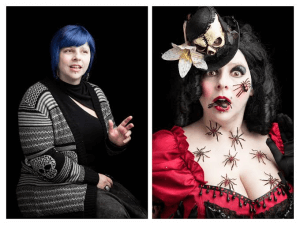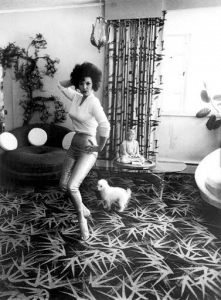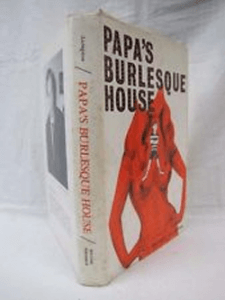“Baltimore isn’t just more fun than D.C., it’s way out there with quirks and weirdness …”
-Mourna Handful, burlesque artist
“The Block” – a half-mile of go-go joints and gin mills on East Baltimore Street that once attracted sailors, grifters, strippers and drifters from around the world – has gone to college.
Students in the Exhibition Development Seminar at the Maryland Institute College of Art are studying, documenting and curating the resurgence of burlesque (vaudeville’s sexy sibling) for which the long-in-decline Block – was long famous.
The work culminates at 7 p.m. on April 22 with “Workin’ the Tease,” a performance celebrating burlesque as an art form made up of slapstick humor, music, dance, and body spectacle striptease. The word “burlesque” comes from the Italian burlesco with roots in burla – meaning a joke or mockery.
How does “body spectacle” striptease differ from the old bump and grind practiced at Depression-era theaters on the Block like the Gayety and the Clover?
The answer lies somewhere between laughter and lewdness.
“Body spectacle implies something more performative and artistic versus a regular striptease which is a means of seduction,” said Catherine Reckelhoff, a MICA student working as a curator and publicist for the project. “In burlesque, the body is a medium to communicate a narrative.”
Of course, the thrill of the naughty and the bawdy will be part of the spectacle at the Modell Lyric, 140 West Mount Royal Avenue, the same street as the MICA campus.
“There is something incredibly liberating about taking your clothes off in public and hearing people cheer,” said “Tease” participant Tapitha Kix, who makes use of childhood tap dancing lessons in her act.
“I did tap and ballet as a child and about six years ago I started going to burlesque shows as a fan. The more I went, the more I wanted to be on stage.”
In addition to Mourna and Tapitha, more than a dozen performers – including “Paco Fish,” “Dolly Longlegs” and the comedy duo “Hot & Bothered” – will pay homage to the history of burlesque in Baltimore and the genre’s theatrical beginnings.
The one-night-only show will be accompanied by an exhibit of artifacts and curiosities – including a life-size image of the fabled stripper Blaze Starr (whose life-size costumes measured 38-D, 24, 37) on display through May 11th.
Those not quite old enough to remember the glory days of Empress Blaze (born 1932 in Twelve Pole Creek, West Virginia and now retired in the Mountain State) may recall a 1960’s sit-com called “My Three Sons” starring Fred MacMurray.
The “sons” included real-life brothers Stanley and Barry Livingston, who played Chip and Ernie on the show. The Livingston brothers’ mother – the late Marilyn Palyash – performed on the Block as Marilyn Primrose.
Palyash’s brother-in-law, Bernard Livingston (also deceased) captured in all in a memoir-as-novel about the Clover called “Papa’s Burlesque House.”
The stock-in-trade at the Clover – commonly known in its day as “the Scratch house” – was decidedly more rakish than raffish.
“Russell Baker told me he saw his first naked woman in the Clover Theater,” said Bernard of a conversation he’d once had with the Pulitzer Prize winning newspaper columnist in a 1992 interview with the Baltimore Sun. “I guess plenty of guys who grew up
-o-
The “Tease” exhibit features photographs by Baltimorean Sean Scheidt that show the new wave of burlesque performers in their day-to-day life alongside of portraits of their stage personas.
“The series of [photographs] started out as a study of the transformation that is brought about by the stage,” said Scheidt, a fashion photographer who grew up in Dundalk, just east of the Baltimore city line.
“I felt that this was most apparent in the few burlesque performers I knew. As the series developed I asked each performer about their relation to the golden years of burlesque and how they honored that heritage – where they fit into the history.
“My involvement is really about the [genre’s] present rather than nostalgia.”
One of the performers photographed by Scheidt is an editor for a Washington-area museum, a big woman known on stage as Mourna Handful. Of the new twists that burlesque has taken, Mourna mentioned a “Lord of the Rings” themed stage show she produced.
“It was called “The Lord of the Pasties: the Two Tassels,” said Mourna, who has been performing for the past five years and has been enchanted by the spirit of Baltimore embodied by folks like John Waters, Edgar Allan Poe and the side-show performer Johnny Eck [1911-to-1991].
At the Lyric on April 22, Mourna will deliver her “Little Miss Muffet” act.
“I use a huge prop that I lay on and dance on,” she said. “It’s the spider.”




FYI, Blaze Starr’s dress is on loan to MICA from the Burlesque Hall of Fame in Las Vegas! BurlesqueHall.com
The display includes pieces from several private collections as well, so this particular assortment of burlesque history and ephemera will literally NEVER be seen together again!
We actually are not displaying one of Blaze’s dresses, unfortunately. (If only our student-run exhibition had the budget to ship an 80-lb [when crated] dress from Vegas to Baltimore, sigh.) However, we ARE displaying vintage Golden Age pasties on loan from the Burlesque Hall of Fame as well as a life-size image of Blaze Starr , originally from an autographed photo of her. We are also displaying a beautiful vintage skirt that was passed down through several generations of Baltimore Block legends (on loan from Margo Christie).
We will also be displaying a plethora of other original Blaze Starr artifacts from burlesque-collector Janelle Smith’s collection.
Thank you so much for the wonderful article!
Thanks for the great write-up, and the mention! This is show going to be amazing, thanks to the great work of the MICA students, and the awesome talent that we will be sharing the stage with!
Yay!